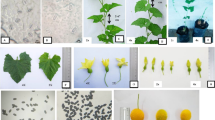Summary
Dihaploids were treated with colchicine by using Dionne's technique. Cytological screening of the products showed there were differences between dihaploids in their susceptibilities to chromosome doubling by this method.
All except one plant out of 85 screened had the same ploidy in L2 and L3 tissues. The ploidy of L1 tissues was frequently different from that of the other two layers. It was concluded that two independent histogenic layers, L1 and L2+L3, may be present in subaxillary meristems of potatoes. Chromosome counts of root-tip cells (L3 tissue) could be made prior to flowering in order to ascertain which plants should be retained for use as functional tetraploid parents in breeding experiments.
Zusammenfassung
Entsprechend der Dionne-Technik wurden dihaploide Pflanzen mit Kolchizin behandelt. Zwischen den Wirkungen von zwei verschiedenen Kolchizin-Lösungen (0,5 und 1%) und Behandlungszeiten (24 und 48 h) ergaben sich keine signifikanten Unterschiede. Signifikante Unterschiede zeigten sich jedoch zwischen Dihaploiden hinsichtlich ihrer Bereitschaft zur Chromosomen-Verdopplung. Die Ploidie der histogenen Schichten L1, L2 und L3 in den Produkten wurde durch Chloroplasten-Zählung in stomatären Wächterzellen ermittelt, entsprechend durch Zählung der meiotischen Chromosomen in Pollenmutterzellen und der mitotischen Chromosomen in Zellen von Wurzelspitzen.
Tabelle 1 zeigt die Frequenzen der Pflanzen mit Tetraploidie in jeder Schicht. Die zytologische Auswertung geschah wie folgt. Zuerst wurde L3-Ploidie ermittelt und die 2x-Pflanzen zurückgestellt. Der Rest wurde auf L1-Ploidie untersucht; Pflanzen, die auch in dieser Schicht tetraploid waren, wurden auf L2-Ploidie ausgelesen.
Die Ploidie von L2 und L3 war für alle Pflanzen identisch, ausgenommen einer von 85 Pflanzen, die in beiden Schichten untersucht worden waren. Die L1-Ploidie war in den meisten Fällen von der von L2 und L3 unterschiedlich. Daraus wird geschlossen, dass subaxillare Meristeme bei Kartoffeln zwei funktional unabhängige histogene Schichten haben könnten, die L1- bzw. L2- und L3-Gewebe ergeben. Wenn sich L2 von L3 unterscheidet, könnte dies auf seltene periklinale Teilungen von L1 zurückzuführen sein. Periklinale Chimären erweisen sich bis zu drei Knollengenerationen generell als stabil. Aufteilung in komplettes 2x- oder 4x-Gewebe erfolgt generell in der ersten Knollengeneration von Pflanzen, die in der L3-Schicht mixoploid sind.
Wenn doppelt Dihaploide für den Gebrauch als funktionale Tetraploide in der Züchtung erforderlich sind, könnten diese zur Zurückstellung identifiziert werden, indem vor der Blüte die L3-Ploidie ermittelt wird, welche sporadisch und unregelmässig sein kann.
Résumé
Des plantes dihaploïdes ont été traitées à la colchicine selon la méthode de Dionne. Aucune différence significative n'a été trouvée quant à l'efficacité des solutions de colchicine (0,5 à 1%) et des temps de traitement (24 et 48 h).
Cependant en utilisant cette méthode, on a observé des différences dans la sensibilité des dihaploïdes au doublement des chromosomes. Les ploïdies de types L1, L2 et L3 des assises ont été déterminées par comptage des chloroplastes situés dans les cellules de garde des stomates, les chromosomes méiotiques par comptage dans les cellules-mères du pollen et les chromosomes mitotiques par comptage dans les cellules de l'extrémité des racines.
Le tableau 1 présente les fréquences de plantes tétraploïdes de chaque assise. Le screening cytologique a été établi de la manière suivante: les ploïdies L3 ont été déterminées en premier lieu et les plantes diploïdes conservées à part. Le reste a été trié pour la ploïdie L1 et les plantes qui étaient également tétraploïdes ont été séparées pour la ploïdie L2.
Les ploïdies L2 et L3 étaient identiques en tous points sauf pour 85 plantes récupérées dans les deux types. La ploïdie L1 était souvent différente de L2 et L3. On en conclut que chez la pomme de terre les méristèmes subaxillaires peuvent avoir deux assises à fonctions indépendantes donnant respectivement des tissus de types L1 et L2+L3.
Lorsque L2 est différent de L3 cela peut être dû à de rares divisions périclines des cellules de type L1. Les chimères périclines demeurent généralement stables après trois générations de tubercules. Des tissus intégralement 2x ou 4x se forment généralement à la première génération de tubercules chez les plantes mixoploïdes en L3.
Dans le cas où des dihaploïdes doublés sont recherchés en tant que tétraploïdes pour des hybridations, ils peuvent être identifiés dans le tri de la ploïdie L3 avant la floraison qui peut être sporatique et peu fréquente.
Similar content being viewed by others
References
Cutter, E. G., 1978. Structure of the potato plant. In: P. M. Harris (Ed.), The potato crop. Chapman & Hall, London, pp. 70–152.
Frandsen, N. O., 1967. Ploidy chimaeras from haploid potato clones.Zeitschrift für Pflanzenzuchtung 57: 123–145.
Hermsen, J. G. Th., M. Wagenvoort & M. S. Ramanna, 1970. Aneuploids from natural and colchicine induced autotetraploids ofSolanum.Canadian Journal of Genetics and Cytology 12: 601–613.
Howard, H. W., 1970. Genetics of the potato. Logos Press, London.
Howard, H. W., J. Wainwright & J. M. Fuller, 1963. The number of independent layers at the stem apex in potatoes.Genetica 34: 113–120.
Kirk, J. T. O. & R. A. E. Tilney-Basset, 1967. The plastids. Freeman, London and San Francisco.
Klopfer, K., 1965. On the evidence for 3 independent layers in the shoot apex of the Potato.Zeitschrift für Pflanzenzuchtung 52: 67–87.
Langton, F. A., 1974. A re-evaluation of the Dionne method of vegetatively doubling the chromosome number in potato.Potato Research 17: 296–306.
Ross, R. W., L. A. Dionne & R. W. Hougas, 1967. Doubling the chromosome number of selectedSolanum genotypes.European Potato Journal 10: 37–52.
Swaminathan, M. S., M. L. Magoon & K. L. Mehra, 1954. A simple propiono-carmine PMC smear method for plants with small chromosomes.Indian Journal of Genetics 14: 87–88.
Author information
Authors and Affiliations
Rights and permissions
About this article
Cite this article
De Maine, M.J., Fantes, J.A. The results of colchicine treatment of dihaploids and their implications regarding efficiency of chromosome doubling and potato histogeny. Potato Res 26, 289–294 (1983). https://doi.org/10.1007/BF02356150
Accepted:
Issue Date:
DOI: https://doi.org/10.1007/BF02356150




